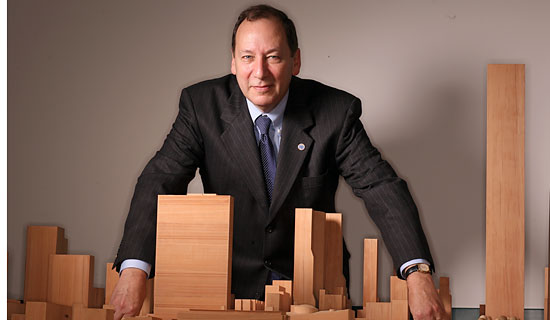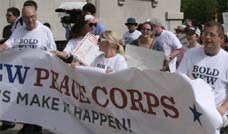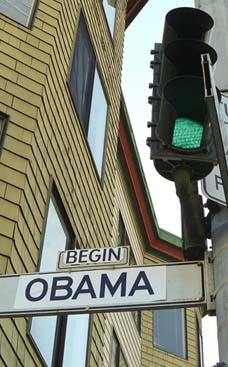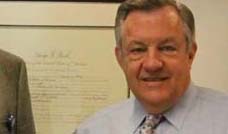
Noting that the General Assembly established the budget of the project at $1.876 billion, he said there was a projected overage of around $219 million last year, but it was diminishing. It was currently projected to be $90 million and he was confident that the project would be completed within the approved budget, partially due to the fact that better bids from suppliers were now being received, because of the economic slowdown. Architect Michael Adlerstein served as a Peace Corps volunteer in Colombia, and is executive director of the $1.9 billion United Nations renovation project.
Press Conference with Michael Adlerstein on the UN Headquarters renovations
The Capital Master Plan for the renovation of the New York Headquarters of the United Nations was substantially on budget and on time, Assistant Secretary-General Michael Adlerstein told correspondents at a press conference this afternoon.
“We remain on schedule, and the project will be completed by 2013,” Mr. Adlerstein reported. “Given the outstanding support we have received from financial contributions from Member States, the financial position of the project is strong,” he said.
Noting that the General Assembly established the budget of the project at $1.876 billion, he said there was a projected overage of around $219 million last year, but it was diminishing. It was currently projected to be $90 million and he was confident that the project would be completed within the approved budget, partially due to the fact that better bids from suppliers were now being received, because of the economic slowdown.
In preparation for the start of the Secretariat’s renovation around November, he said, staff relocations began in earnest in April, with 160 staff moved to swing space. That will grow to around 400 moved each weekend throughout the summer, with about 6,500 staff relocated by the end of October.
He said that around 3,000 of the 5,000 staff that work at the Headquarters complex would be shifted outside the compound, with around 2,000 to swing space in the temporary building, in the basements, or in the Library and the South Annex buildings, which will undergo renovation last. The 1,500 staff presently in offices outside the compound would be moved in order to allow the departments to be better consolidated.
He said that construction of the North Lawn and the fit-out of other swing spaces were on schedule for occupancy this fall. The North Lawn building would first be used to house the functions of the Conference Building, and afterwards that of the General Assembly area.
In addition, he said, the temporary building would house the Delegates’ Lounge, the press stakeout area, the Advisory Committee on Administrative and Budgetary Questions, the President of the General Assembly, the temporary Café Austria, lounge areas, office space for security, and other functions that must remain in the compound. The 3rd floor would host the Secretary-General and the Executive Office of the Secretary-General.
The first work to be done in the Secretariat tower would be moving the data centre from the 19th and 20th floors to the 2B level of the North Lawn Building. Clean up and demolition would then start, followed by replacement of the glass curtain wall, which should be finished by the end of 2010. The interior work will then commence and the Secretariat should be able to be reoccupied two years later.
The renovation of the Conference Building would start slightly after work on the Secretariat and take two years, he said, with conference rooms relocated to the North Lawn one by one. The first to move would be Conference Rooms 4, 5, 6 and 7, which are actually in the basement of the General Assembly Building. As soon as those moves were completed, the rooms would be modified to host the Security Council chambers for two years.
He said that discussions on space planning for the media were ongoing. The daily briefing would be relocated to the Dag Hammarskjöld Auditorium and the media would be provided work areas in the Library wing. A stakeout location near the Security Council would also be provided, in line with existing practice.
Following Mr. Adlerstein’s presentation, many correspondents asked for clarification of the arrangements planned for the media, saying that they had recently heard of plans to charge tens of thousands of dollars for office spaces, when they thought a more favourable arrangement had already been agreed upon.
Mr. Adlerstein replied that there was a constructive dialogue still going on with the United Nations Correspondent’s Association (UNCA) on the issue, but it had already been made clear that there was no intention of charging for swing space for correspondents. There were still a few years left to discuss the situation of space in the renovated building. Broadcast booths in both temporary and renovated situations would still be provided free of charge.
The correspondents said they were reacting, however, to reports that enclosed offices would be charged for, which would be untenable for their operations, since they needed private space due to the competitive nature of the business, and having to pay for it would hurt United Nations coverage since media outlets were struggling. They requested a written statement of what was being proposed.
Mr. Adlerstein promised to issue written information after the briefing. In any case, he said that there would be seven-foot partitions separating the spaces, the same as for all professional staff of the United Nations. “The culture of the UN is moving toward open offices,” he explained. The $23,000 being considered for enclosed offices represented the straightforward construction cost.
Asked if staff was being consulted on all plans, he said that there were ongoing monthly town hall meetings as well as dialogue with the Staff Union. Asked about security, he said it was an issue for the Department of Safety and Security, but he knew that security risk assessments for swing spaces were still due to be completed by the end of June, with recommended modifications to be made afterwards.
He added that there had been anxiety expressed by staff over the removal of asbestos, but that it would be done “by the book” and in compliance with all regulations. In regard to staff relocated to the third basement, he said that the area was well-ventilated and temporary; there was consultation with New York City about the legality of PVC pipe in temporary toilets there.
He said that litigation in California against the main contractor, Skanska, had been resolved. There had been subsequent civil litigation, but in the context of construction, this was not unusual.
He pledged to work with members of the media to resolve issues of construction noise and access for equipment. Asked further questions about the journalists’ space arrangements, he said, “I hope in the next few days we will resolve this.”
Published on: 2009-06-04












